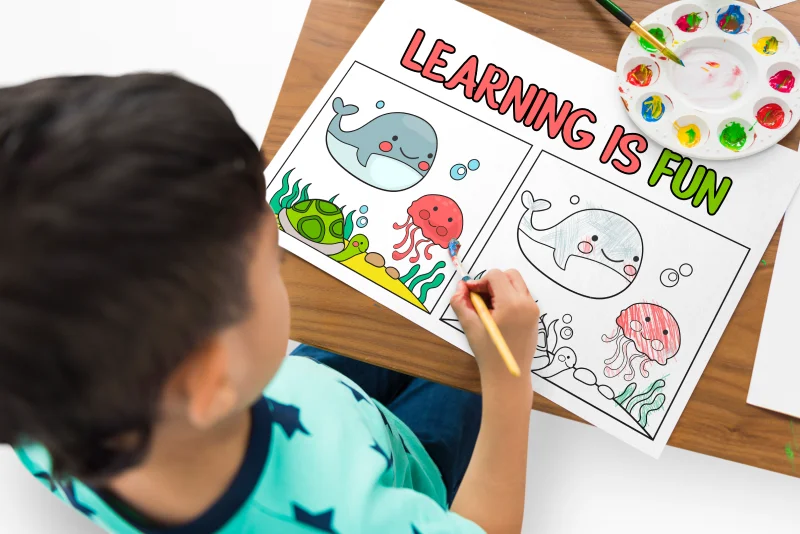You will find different quality levels of education in different countries throughout the world. But there are two things you will find common. One, traditional learning methods are now being considered ineffective, and second, everyone is looking beyond the rote learning and boring lectures. The whole world is seeking engaged and interaction-based learning methods.
From different research conducted throughout the world, we can now say that children or students learn differently. Each student has their own learning ability and style. Some students learn better by visualising things, some by listening, and some by manipulating the learning material or experiencing it.
Interaction-Based Learning: The Future of Education

Today, we have evolved to such a level that we have evidence and resources to shift from those ineffective learning and teaching methods that only benefit a few. A child may learn fine through rote learning, and at the same time, another child would be struggling in that system, because they have different learning abilities and styles.
In such a situation, there is one way that fits every child’s needs and that is the active engagement and participation in the learning. We can evidently say that children who learn through interacting with the learning material, learn better, understand concepts deeply, and develop necessary life skills like problem-solving, critical thinking, and creativity.
So, what does interaction-based learning mean?
In simple terms, interaction-based learning means when a child actively engages with the learning materials by interacting with them. For example, when a child plays with clay to learn about shapes or use number blocks to learn maths, the child is learning through interaction.
In the 21st century, the interaction-based learning also leverages technology to create an environment in which kids or students can explore, create and interact with the study elements.
The Era of Education 4.0

Since the past few years, we are not just going through the third industrial revolution (technology and IT); we are also in the era of Education 4.0.
In this educational transition, children learn by actively participating in the learning process, and augmented reality (AR) is at the forefront of creating such an environment.
Augmented Reality (AR) seamlessly complements current educational materials, enabling the adoption of interaction-based learning. The AR brings the learning elements to life in the form of 3D characters. Imagine a child, who has never seen an actual elephant, learning about them by interacting with a 3D virtual elephant created using AR. The child can now understand better because the elephant (or the learning material) is not just a static image on a textbook page.
Revolutionizing Learning with AR: Engaging All Learning Styles
AR makes the learning tangible. This does not only benefit the visual learners, but it also encourages students with different learning styles to be actively involved in the learning process through engagement that results in a better understanding of concepts for every child. Children can even have virtual field tours. For example, history students can visit virtual pyramids, and environment students can visit virtual forests, without even leaving their classrooms. Imagine the difference and impact of understanding with this method compared to if the students only saw the pyramids or forests only in the textbooks. Now, they can interact with the environment around them in the virtual tour, which is not possible in the traditional learning method.
Personalized Learning with AR: Catering to Every Student’s Pace and Interest
The use of technology in the interaction-based learning method is not limited to AR-powered virtual field trips. As discussed earlier, different students have different learning abilities and styles, and with the help of technology, the students can now have personalised learning. No student would feel left out because of their learning pace and style. For a better understanding, a student can revisit the lesson again and again until they feel confident about the concept. The interactive feature of AR allows such students to manipulate the learning element according to the child’s curiosity and understanding. For example, a student might be interested in how a lion roars, and at the same time, another student might be interested in how the lion preys. They can both manipulate the virtual 3D lion to learn about the lion’s particular behaviour separately.
The role of StartAR in interaction-based learning
StartAR is a true interaction-based learning platform. Through years of experience with the motto of making the learning more fun, effective, and based on the principles of education 4.0, StartAR is pioneering interaction-based learning through our AR powered textbooks and app. We have created an immersive learning platform that makes learning not less than an adventure. We utilise the physical act of reading, equipped with the power of AR, to enable the always curious little learners to provide better education with active engagement.
Prepare for the future, today!
It took almost centuries to reach a level where the world has started acknowledging the fact that each student has their own style of learning. But this is still not that prevalent as it should be. As parents, teachers, or educationists, we should understand that the future of learning is not at all passive absorption of knowledge. We should also understand the challenges faced by each student because of their unique learning styles and abilities.
To help us in that, we can easily embrace technological innovation to provide an environment in which each student actively participates, engages and interacts with the learning materials, powered by advanced technologies like AR. And, as a result, we can encourage students to learn better and prepare them for the future by making them lifelong learners, critical thinkers and problem-solvers.